The ears are well broken in, I've lost the perma-grin and I'm up to date on my movies.
Its time to play!
Over the last couple of months I have been doing a lot of reading on the 2nd most important influence on the quality of sound: the room. I have become convinced that there are reasonable things one can do to significantly improve the sound quality of
any audio system.
The starting point is of course, figuring out exactly what your speakers are putting out. For the last few days I have been playing with a program from the folks at hometheatershack.com called Room Equalization Wizard (REW). I gotta say this is a pretty slick program! These days everyone has a computer, and for the cost of a few extra cables and an spl meter (which we all have anyway right?) this program is a no-brainer.
Here is what I have so far.
The layout:
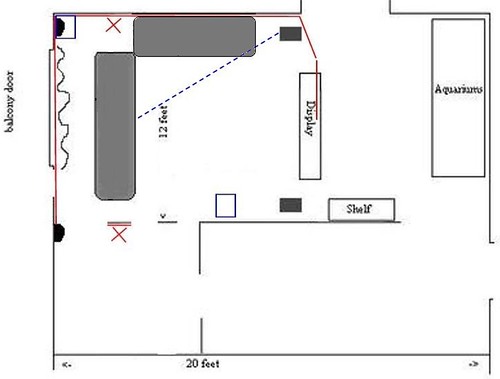
The surrounds are now where the two Xs are. With the FR speaker being blocked by the couch this channel is boosted by about 2-3db to compensate.
The Sub:
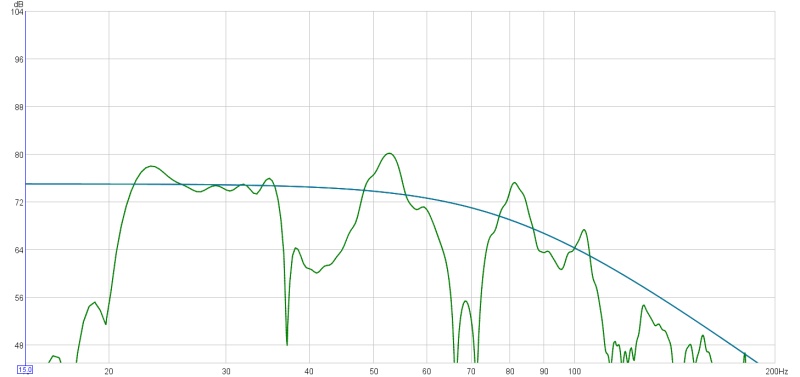
The good news is that I am getting extension down to 22Hz. Not bad considering the posted specs list the -3db point as 28Hz and the sub is not corner loaded. The bad news is the huge dips around 40 and 70Hz. Yuck.
By the way, I had never level matched the sub until two days ago. It seems I was running the sub a little hot. I turned it down from about 1:00 to around 10:00, about 15 'clicks' on the dial!

Sub waterfall:

Everyone probably already knows this, but the waterfall plot shows how fast each frequency decays. The Z axis on the graph it time, so wherever you see a ridge extending out for any significant time, that frequency is being reflected around the room.
For fun I also plotted the sub + mains:
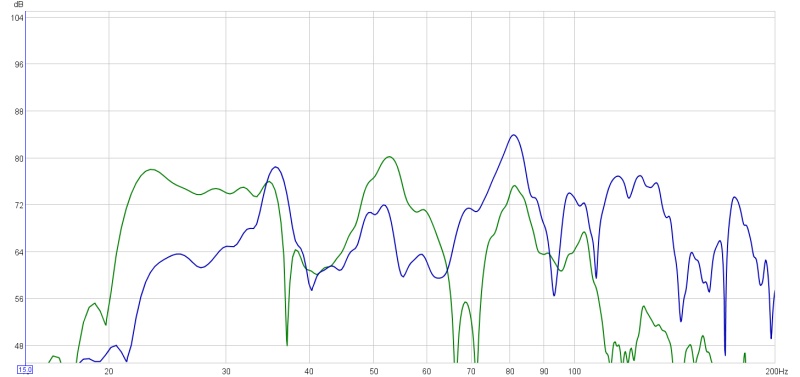
I did not db match during pre-sweep level checks, so the dbs for each trace are different, but you get the idea.
What surprised me here was the big boost at 37Hz. I know the M80s reach low, but with the high-pass roll off I didn't think the mains would contribute much this low. I bet there is a room mode at play as well, but still...
It’s interesting how some frequencies are boosted and some seem tamed. The 52Hz area does not look quite as bad with the mains in, but yowzers! Look at 80Hz.
I didn't upload the waterfall for the sub+mains sweep, but it looks like I get my boom from 37, 52 and 80Hz. I'm also missing a lot between 38 and 70Hz or so. Maybe thats why I wanted to turn the sub so high.
Once REW is set up, measurements are a snap. Set up the spl meter, check to make sure the meter is calibrated to REW test signals, check levels for the chosen location and measure. I spent more time waiting for my fridge to turn off than making measurements.
Those dips you have are very severe, You may want to play around with phase and placement to see if you can get rid of them. You'll probably be surprised how much of a difference it can make. I have my subs and M80's hooked to a Behringer DCX2496 which is an active crossover and eq among other things and had been playing around with REW for a while. A few tweaks later I am able to get a pretty flat response, It definetly is a handy program

I forgot about adjusting phase. I definately plan to play with placement, though my options are limited.
Nice work Fred. Someday I hope to have some spare time to do what you are doing. I have had REW downloaded on my hard drive for over a year and have yet to fire it up!
I actually considered this stuff fun for awhile too, until it became clear that I wasn't able to do anything about my "valleys and nulls" that didn't involve a general contractor!

I never used that program though....maybe someday I'll give it a shot!
One thing to note, however: I'm not really familiar with waterfall graphs but will will mention that lower frequencies will
always have a much longer decay due to their much longer wavelengths....
Still, it's nice to see somebody else' semi-sucky room to start my day off with a smile!
Evil for the month of September, remember?

Fred - I'm sure you remember I went through the same fun (I think?) with my own poor room modes when I first picked up the EP600.
This was what my raw output looked like where I first had my sub:

I had some ugly dips at around 35 and 60 hz. I ended up getting the Behringer Feedback Destroyer (fondly known as the BFD) to smooth responses, but what I found was that these types of dips (-20 dB or more) weren't correctable through any other means than moving furniture or moving the sub itself. The best I could do in that position, even with the BFD, was to get the curve to about -12 dB at 60 Hz (and other ugly problem spots as well), which was still way too much of a drop off for me to be happy with.
Fortunately in my case better results were achievable without moving walls.

Now take a look at what happened just by moving position of the sub, this is still before using the BFD in the new position:
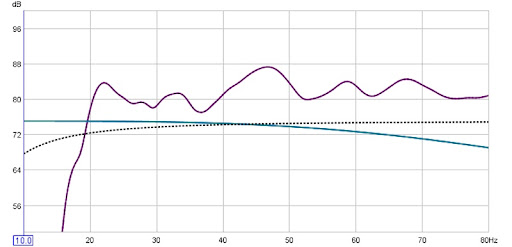
Moving the position caused the response to move from +/- 40 dB to +/- 10 dB (and my satisfaction level with my EP600 to go from 0 to 100).
Then, finally, I applied the BFD adjustments to my curve and achieved the flattened curve I was looking for:

The moral of this long story filled with squiggly lines and charts? Even though I know you've said you have a tough room, definitely experiment with different locations for the sub to see if you notice a difference (primarily with your ears, but also with the REW curves). Also, like you said, adjust the phase options to see if it makes a difference, though in my case even phase adjustments in the first position were not terribly helpful. It was just a very bad location in the room. In the second position though, and especially after adding a second sub, the phase adjustments became critical to smoothing response throughout the room.
Have fun, keep us posted!
Jason
I have had REW downloaded on my hard drive for over a year and have yet to fire it up!
And I thought I was bad.

I've had rew downloaded for a couple of months now. I have spent a lot of time reading up on the various options for taming my room though.
Still, it's nice to see somebody else' semi-sucky room to start my day off with a smile!
Semi-sucky? Semi-sucky!! I'll have you know that I am surrounded on 4 sides by concrete! My room is mondo sucky. Its the KING of sucky.
Jason. I do remember you went through some fun. For some reason, the second and third graphs in your post are not showing up.
I expect it may take a while for me to get through this. As has been mentioned by several people, my options include adjusting phase, moving the sub, adding a sub, moving furniture and one not mentioned, bass traps.
I have already checked a position about 1.5 feet closer to the front of the room. That would put the seating position at about 35% of the way from the back of the room. I seem to remember this as being the 'magic' spot. That helped a little with the 37Hz suck-out, but its still ugly. Moving the couch forward is the only furniture moving option.
For moving the sub, I only have two other places: the back corner or between the right speaker and the TV.
Edit: Hmmm. Looking at the room layout, I could also try the sub in the other 'not quite' back corner. I bet that would do funky things to the bass in the Kitchen!
I will probably try corner bass traps at some point, but I don't think they are very effective down below say 100Hz. I expect my room will need help in the 100-500Hz area where corner bass traps are more effective.
Fred, well at least you've been able to make Mark Johnson feel better! On the sharp dips shown, one point to keep in mind is that both the positioning of the sub at a null and the microphone(or your ears)at a null can result in such dips. For example, someone sitting in the middle(horizontally speaking)of a 15' wide room would experience a dip at about 560/15 or 38Hz. Your room dimensions plus sub and ear positioning will change these effects.
(is there an echo in here?)
Re-posting with hopefully working picture links... sorry for the spam. [Google web albums changed the way you embed images stored there and it looks like I guessed wrong the first time]
RE-POST FOLLOWS
Fred - I'm sure you remember I went through the same fun (I think?) with my own poor room modes when I first picked up the EP600.
This was what my raw output looked like where I first had my sub:
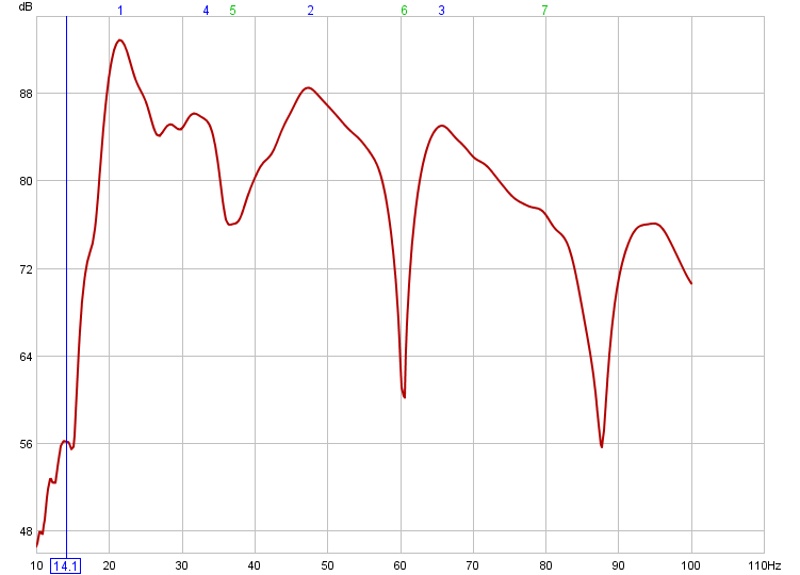
I had some ugly dips at around 35 and 60 hz. I ended up getting the Behringer Feedback Destroyer (fondly known as the BFD) to smooth responses, but what I found was that these types of dips (-20 dB or more) weren't correctable through any other means than moving furniture or moving the sub itself. The best I could do in that position, even with the BFD, was to get the curve to about -12 dB at 60 Hz (and other ugly problem spots as well), which was still way too much of a drop off for me to be happy with.
Fortunately in my case better results were achievable without moving walls.
Now take a look at what happened just by moving position of the sub, this is still before using the BFD in the new position:

Moving the position caused the response to move from +/- 40 dB to +/- 10 dB (and my satisfaction level with my EP600 to go from 0 to 100).
Then, finally, I applied the BFD adjustments to my curve and achieved the flattened curve I was looking for:
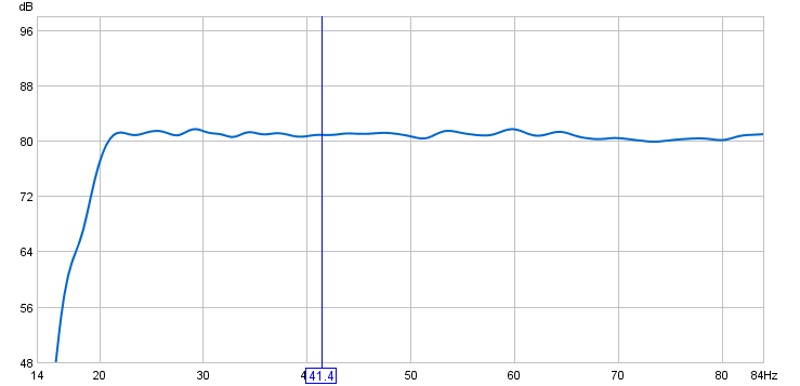
The moral of this long story filled with squiggly lines and charts? Even though I know you've said you have a tough room, definitely experiment with different locations for the sub to see if you notice a difference (primarily with your ears, but also with the REW curves). Also, like you said, adjust the phase options to see if it makes a difference, though in my case even phase adjustments in the first position were not terribly helpful. It was just a very bad location in the room. In the second position though, and especially after adding a second sub, the phase adjustments became critical to smoothing response throughout the room.
Have fun, keep us posted!
Jason
do you have any smoothing applied to those graphs? The last one is very impressive!
I know, I couldn't believe the last one either because the room is totally non-treated (i.e. no traps, etc.). I used the BFD (see above) to equalize the curve, but even so, I never expected it to get that flat.
I later added a second sub into the mix and could never get it this flat again, however, the response in general in multiple listening positions is better with two subs, it's just not as perfectly flat in the primary listening position (maybe it could have been, but I gave up tinkering at some point)

I keep not seriously tinkering just because I know my system is going to change. I swear I'll put in the effort once I have my final two surrounds and my multiple subs and it's in the room I want it in.
Unless you really enjoy the process of tinkering, if multiple subs is in your future, I'd wait until you do that too... it adds such a ridiculous amount of complexity to bass tuning that you'll likely want to pull your hair out... at least if you wait you'll only have to do it once.
And the adventure continues.
Unfortunately, moving the sub around did not yield a nice curve like Jason's, no mater wher I put it.
This is about as good as it gets. Sub at the side of the room facing forward:
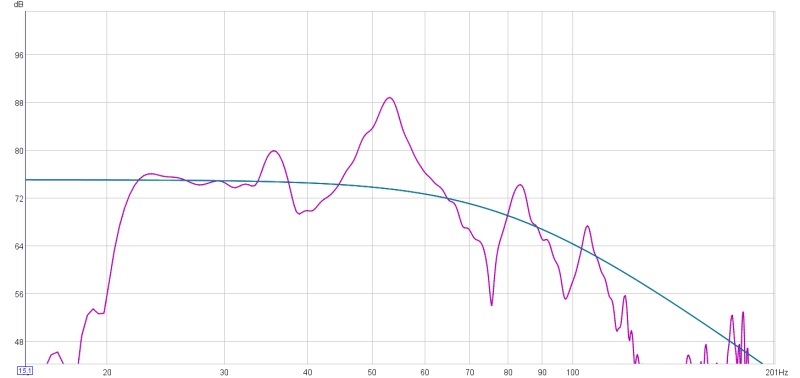
That rather nasty peak at 52Hz (+15db) is killing my bass. The question is, what do I do about it?
Equalization via BFD is an option, but that only fixes the main seating position and it could well make other positions worse.
I went out and did a bunch of reading on various traps, positioning and effectiveness. I also went back to re-visit room modes and mode calculators.
So, plugging my room dimensions into a calculator I see that I have room modes at 28, 56, 84, 112Hz relating to room length. Those match up quite well with what I see in my graphs.
I also have a vertical room mode at 70Hz that sort of matches with the nasty null I see in the 70-75Hz range depending on where I measure and sub position.
It seems that the fiber traps that most folks use are not all that effective down low unless they are very thick and well out from corners or walls.
That leaves resonating absorbers, which work on sound wave pressure rather than velocity. They work well in corners and against walls. Sigh. I can't believe I am contemplating playing with plywood to make my HT sound better.
Concrete sucks!!

Fred, well at least you've been able to make Mark Johnson feel better!
As long as this fiddling acomplishes something.
Its been interesting to watch things change as I moved sub and microphone positions. Peaks and nulls seem to move up and down, and shift in frequency, but the same general pattern appears no matter what. For giggles, I will try measuring at a different vertical location (something other than ear height) next time I fire up REW.
Just because I can:
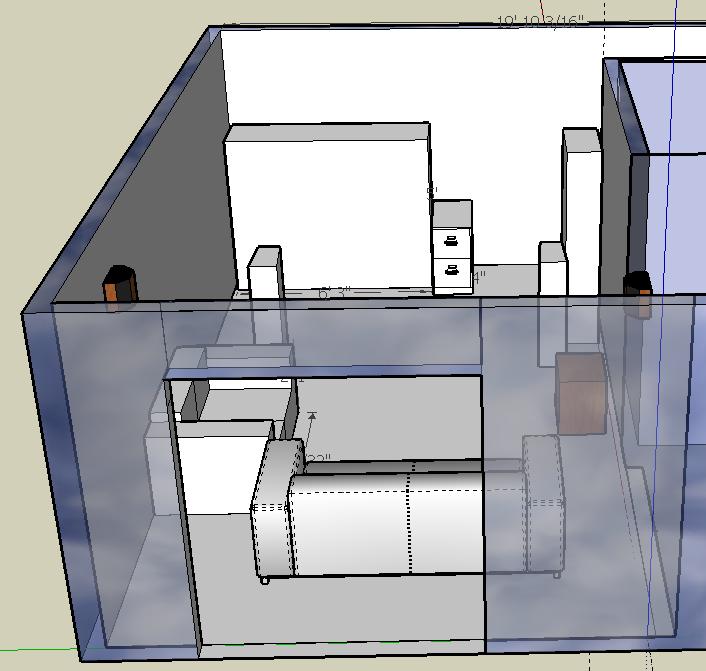
I got bored and decided to play with google sketchup. Thats a neat tool. I remember being at a trade show in the 80s where a rep from Alias was doing similar stuff... on a $10,000 SGI graphics workstation.

Another 10 years and we'll be modeling dinos on our desktop.
Anyway, I thought a 3d layout might give a better idea of just what the limitations of my setup are.
Thanks Fred - I love Google Sketch up. Totally addictive little tool. I obsessed over it when building my riser (and it paid off), so it's fun and effective.

Totally addictive little tool
I realized that after doing the QS8s.

I'm still working through the basics of room acoustics to get a handle on what I can do. Outside of the usual broadband traps there is not a lot of info. available online. I'm gonna pick up the Master Handbook of Acoustics sometime this week.
I got one good tip for getting a handle on room modes and where they come from. I will be rigging up a couple of broadband absorbers that I can move around to see what effect they have. By placing them near the spl meter and changing their orientation in the room, I hope to get confirmation of what peaks and dips relate to the different room modes. Hopefully that will help me to figure out where to place any absorbers I build (aside from the obvious corners).
I am hoping to confirm that the 52Hz mode is related to room length. I want to try a panel resonator at the front of the room above the aquariums.
Fred - did you try calling the folks at RealTraps? (http://www.realtraps.com/). I've seen multiple accounts at AVS Forum of them offering very complete advice once you tell them your situation. Of course they're going to recommend their own products to solve your problem, but it's at least a very good way to get direction on what is correctable using room treatment versus what is not. From what I've ready they'll give you a straight answer.
Jason
I havn't. Since I don't plan on buying any premade traps, I don't like to waste peoples time. Besides, I have seen Ethan Winer's opinions on a studio forum. Very seldom does anyone recommend resonator traps, even if they are acknowledged to be useful in some situations.
Fred,
What card did you use to perform your testing? I'd probably do this with a laptop but I do have a noisy desktop (already 'sounds' like a bad idea :D) as an option.
I downloaded the software and realized reading through the instructions I'll need something to tie my SPL in to the program.
Also...a stupid question. This is primarily to improve bass right? Or will this tell me about all my speakers?
-Nick
I used the mother board's onboard audio. What you need is both a line in and a line out. Mic in dosn't work.
Most people use it for bass, but with a better microphone, you can measure the full range.
If you are interested, read through the REW and calibration forums. Make sure to read the REW FAQs more than once. Everything you need to get you going is in there.
Line in, line out, no mic. Got it. Thanks!
-Nick
I believe if you are using a Radio Shack SPL meter you can get calibration files that allow accurate reporting of all frequency ranges or am I thinking of another program? It's late or early depending on your point of view, time for bed.
They have calibration files for several versions of the radioshack spl meter and for the galaxy mic.
Update:
I finally got around to sourcing some acoustic fiberglass and built myself some 2' x 4' x 6" panels for testing. The results were interesting.
The most notable items:
1. when I checked my calibration I noticed that I had lost 2db on my front right speaker. I noticed the side couch was out of place so I moved it back 6" so that it was now 25" from the speaker and got my 2db back.
2. I thougt I would try the two panels on the kitchen table (dining area) about 3.5' from the wall. The result was a graph about the same as putting both panels across the back corner floor to ceiling.
3. All of the positions eliminated the 42Hz hole.
4. I saw a +3db gain in the 22-28Hz area. Didn't think I would see any effect this low.
I am encouraged and will probably pick up another bale of acoustic glass soon.
I will post graphs tomorrow. Gotta get some sleep now.
I've always been a advocate of how acoustic bass traps and first reflection panels help the overall frequency in a room. It was obvious when I compared my before/after graphs. HT environments are no different than recording studio's when it comes to the positive outcome you see.
Yeah, but what do you do when you don't have room for corner bass traps, and only a couple first reflection panels? That is my dilemma, but I won't hijack this thread, plus I'd have to post pictures of my home theater, and any more it seems so lame compared to others...
I'm sure Fred won't mind if you join his Excellent adventure. After all... "Bill" didn't go without "Ted," on the first excellent adventure, maybe Nick shouldn't go without Fred either.

Jason
Nick. The more the merrier. Maybe an extra poster will help keep the thread on topic when the hi-jacking crowd shows up.

You must not have seen the pictures of my butt=ugly mancave. I know how you feel. There are a lot of very nice HT's around here.
I have a similar problem to you. If you take a look at the sketch I posted you will see that I only have one corner in the 'main' room to work with.
The purpose of my testing last night was as follows:
1. Will broadband traps do anything to the low bass in my room
2. What frequencies will different placements affect (confirm room modes)
3. will the limited placement options I have make any difference
I will post pictures and graphs tonight when I have time.
Estimated Completion: Summer 2007
I was just gonna say this calls for a flux capacitor.
Welcome to hive mind, Fred!
Estimated Completion: Summer 2007
Hey, now that is just mean!
I'll have to update my website so that it just says "Estimated Completion: Sometime In The Future"....
Fred, do you have a phone booth?
What number am I thinking of????
Sixty-Nine!
You know, I didn't get that joke for years...of course, I only watched that movie when I was a teenager.
I see the Horde has arrived
Fred, do you have a phone booth?
Nope, but I can hum the Dr. Who theme song backwards.
Here are two pics of the panels I built.
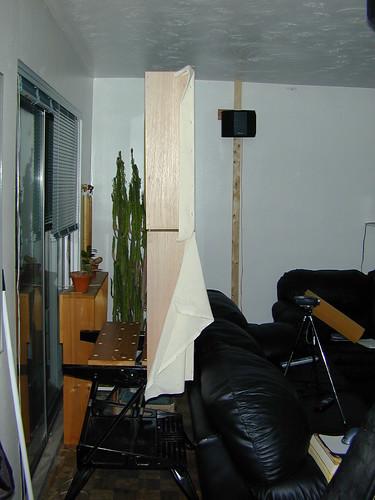
Side view of the two panels stacked behind the spl meter. They are about 2.5 feet from the back wall.
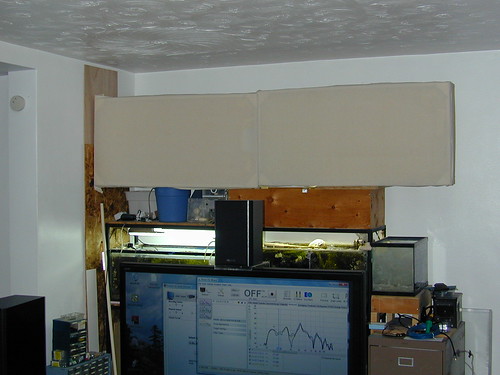
At the front wall about 2 feet out from the wall. I have room here to almost double the treatment size if I fiddle with my aqm. lighting a little.
Fred, in your first picture, it looks like your SPL meter is horizontal facing your mains. I could be wrong, but I'm pretty sure I read it should be vertical for measurements. (I have no idea if it makes a difference, but do remember reading that somewhere).
Jason
The panels are made using 1/8" ply with corner braces to hold them together and hold the fiberglass panels in place. I used thin ply to keep costs and weight down as these are strictly testing panels. It worked quite well and I will probably keep these two the way they are.
Charts:
The purple trace in all plots is the untreated response and is put in for comparison.

This one is the rear wall location you see in the first photo. I was quite surprised at how low the panel effected things. You can see some smoothing in the 22-33Hz. range.
The other big surprise was the elimination of the 40Hz hole. You can also see a reduction at 80 and 120Hz suggesting that this is a room length mode.
The big dissapointment: it got worse at 52 Hz.

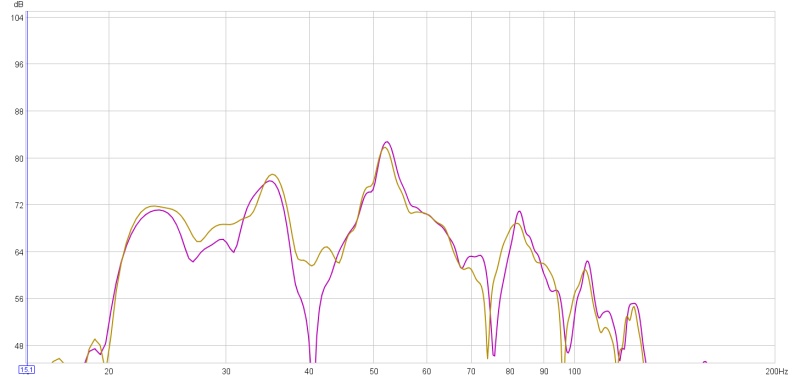
Front Wall placement (2nd pic). Slight improvement at 52Hz and the 75Hz null narrows quite a bit.
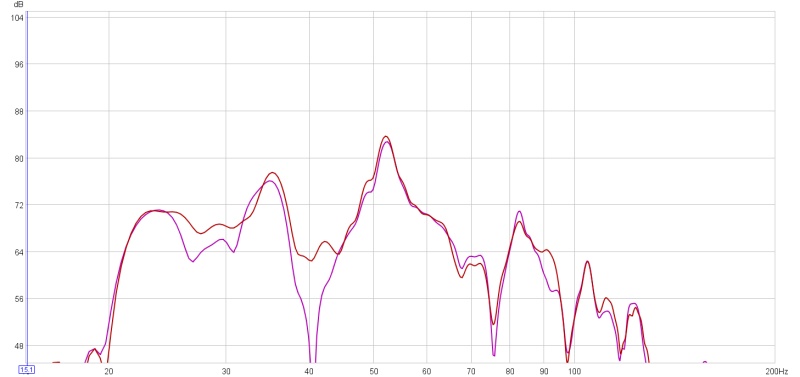
Corner Placement. Interestingly here the 75Hz null is reduced a little, but not narrowed.
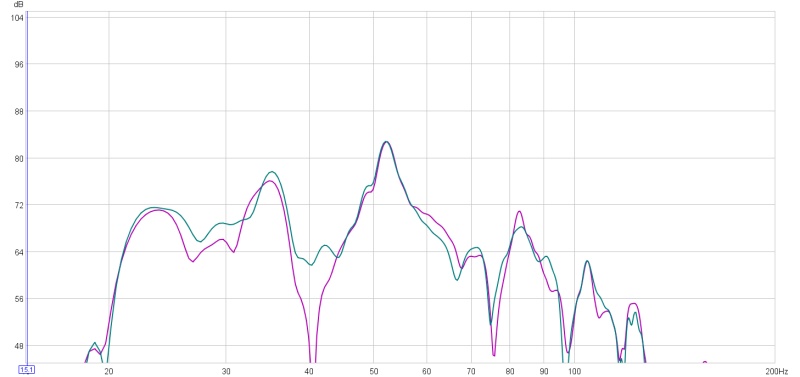
I was curious to know how the dining area affected the room overall. A lot of the effects are the same as other placements, but this one shows the best improvement in the 75Hz null. I wonder if this is a room mode somehow related to the width at this part of the room?
I still want to put the panels over the spl meter to see how that effects things.
Jason. It is omni-directional mics that are supposed to face strait up. The RS meter is directional and should be facing the speakers you are measuring. Since bass frequencies are omni-directional it should really make no difference which way the meter points (I think??).
When I was doing the leveling, I tried various positions with pink noise playing from one speaker and it made absolutely no difference in the spl measured.
I should try doing sweeps horizontal and vertical to see what happens.
Fred:
I hope I'm wrong here, because as a fellow member of the "Rooms that Sucketh" Clan, I'm hoping you're finding some solutions.... but.....
I don't think your panels are reducing that 40Hz hole. My understanding is that any absorbers that would make a difference in bass frequencies would need to be much thicker...and ideally corner-mounted.
Again, I could be wrong...
A question: Was the "before" plot done immediately before adding the panels, and with the mic in exactly the same place, or was it taken from previous tests? Because a mic position just a few inches one way or another over two different testing days might be responsible for that change you see at 40Hz....
Mark. Yes, that is exactly what I did. I moved the panels into the bathroom so they would not interfere with measurements. I then set up, calibrated and measured to get the untreated graph.
From there, I put the treatments in position and measured again: no moving the mike, no level adjustments. I have measured at this position on at least 4 occasions, so with slightly different mic positions, and always get the 40Hz hole
FWIW, the reason that corners are good (as I understand it anyway) is that you can treat multiple modes (length & width, axial & tangential) in one place. It has to do with the way modes accumulate in corners.
So, I to hope you are wrong this time. I am contemplating making a set of thinner pannels to see what the difference is between the two.
Or you can try moving the panels away from the wall. I have two panels, one behind each speaker, and they are about 6-8 inches away from the wall. I think the idea is to "trap" the lower frequencies in the created gap.
That reminds me, I need to run some frequency sweeps and graph them again. I forgot what difference they make.
In the front rear and dining area positions the traps were between 2 and 3 feet from the wall. I did this on purpose to get the maximum absorbtion from the panel (closest to 1/4 wave points, and at maximum sound wave velocity).
I can permenantly install the traps at the front location with the front of the trap at 22" from the wall, pretty much where they were for the test.
I am specifically interested in how much of a difference thickness will make at a given location.
So, I to hope you are wrong this time.
It looks like I am, and I hoped so too! This means there might be hope for my room as well without having to put in absorbers that reduce my (already small) square footage another 25%!
Huh. Mark with "hope". This should be interesting.
Pass the popcorn.
Here ya go. I'll dash out and get some beverages as well.
You get no pity from me - I had axioms in a dorm room for 3 years.
This one's for you Mark.
I have a bit of an epiphany the other night as I was staring at my room wondering why I have such a nasty intractable 52Hz peak.
I have been looking at my apartment all wrong. My HT is in a 20' x 19' room with a large obstruction called a Kitchen. The outer boundry walls are either poured concrete or concrete block. The kitchen walls are probably plaster on metal lath. The room is open the full 19' at both ends (hallway and dining area with the kitchen sitting between, breaking up the room a little.
I live in square room suckage! ::waaaface::
WOOHOOOOOO!!! I now have a room that sucketh a little less.
I picked up a BFD DSP1100 second hand on the weekend and have been playing to get it set up.
I used some automatic features in REW to generate a set of filters for me. As a test I entered the 56Hz filter into the BFD and ran two measurements in REW, with and without filter.
The filter result was damn near exactly what REW predicted it would be.
I'm so excited!!
Blue is with the filter engaged.
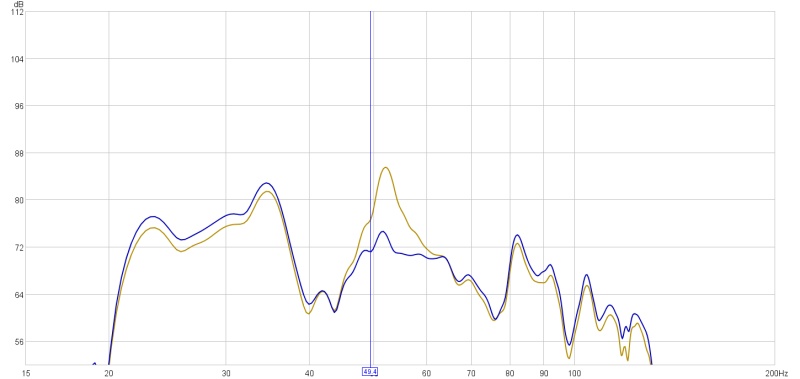
I added 3 more filters tonight and surprisingly the overall effect is very subtle. Its hardly noticeable at all for music even stuff with reasonably low pipe organ notes.
I tried the filters out on LOTR Cave troll and Balrog scenes, and the difference was more noticable, but subtle. There was a reduction in boom for some of the low lfe stuff and maybe a little tightening in the sound like where parts of the bridge start to collapse.
I am quite surprised a 14db cut at 52Hz seems like such a subtle difference.
....and I just can't hide it!!....
Have you tried moving your sub around and playing with the BFD now that you have it Fred? Maybe you can find a more suitable position that you can tweak slightly with the BFD?
That's it Fred!
One more improvement and you're outta the club!

I was trying to make room for Bob, but he got jelous and left. Some people...
Have you tried moving your sub around and playing with the BFD now that you have it Fred? Maybe you can find a more suitable position that you can tweak slightly with the BFD?
I don't have a lot of placement options, but the back corner placement did get rid of the 40-45Hz null, so I will give that a go.
My feeling is that what we call boom is created by reflections. What happens is that the reflection of the 'attack' part of the reflected signal tends to drown out the natural decay you are meant to hear. Once that note/signal bounces back and forth several times, it changes the character of the sound resulting in boom. The only way to deal with that is bass trapping, and for low notes that takes a LOT of traps























